Physical Address
304 North Cardinal St.
Dorchester Center, MA 02124
Physical Address
304 North Cardinal St.
Dorchester Center, MA 02124
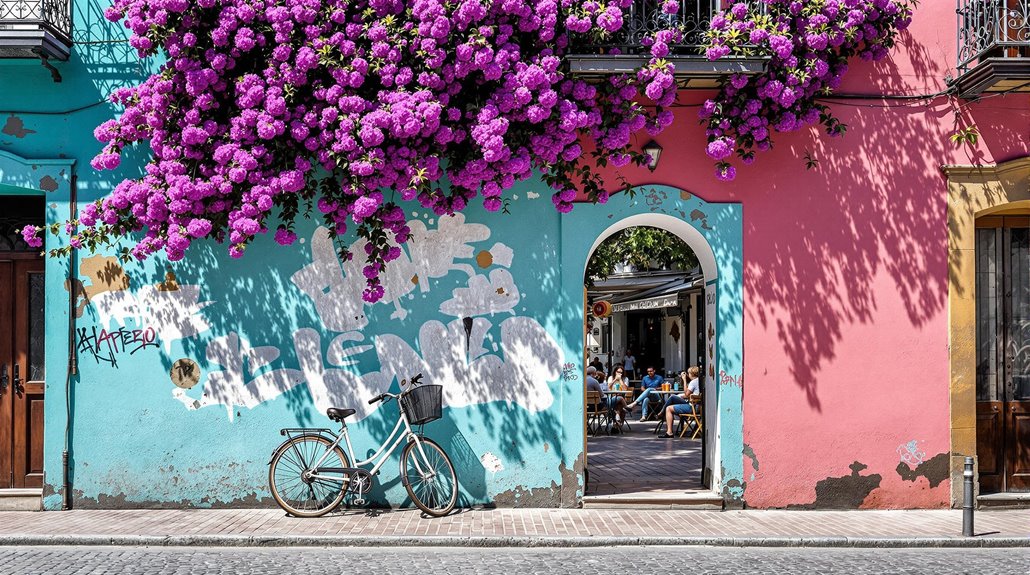
You'll discover that Buenos Aires isn't just another big city – it's a patchwork of distinct neighborhoods, each telling its own intriguing story. From the cobblestone streets of San Telmo to the mind-bending circular layout of Parque Chas, these seven districts offer more than tourist snapshots. Whether you're hunting for vintage records, craving local empanadas, or chasing street art, these lesser-known barrios will reshape your understanding of Argentina's captivating capital.
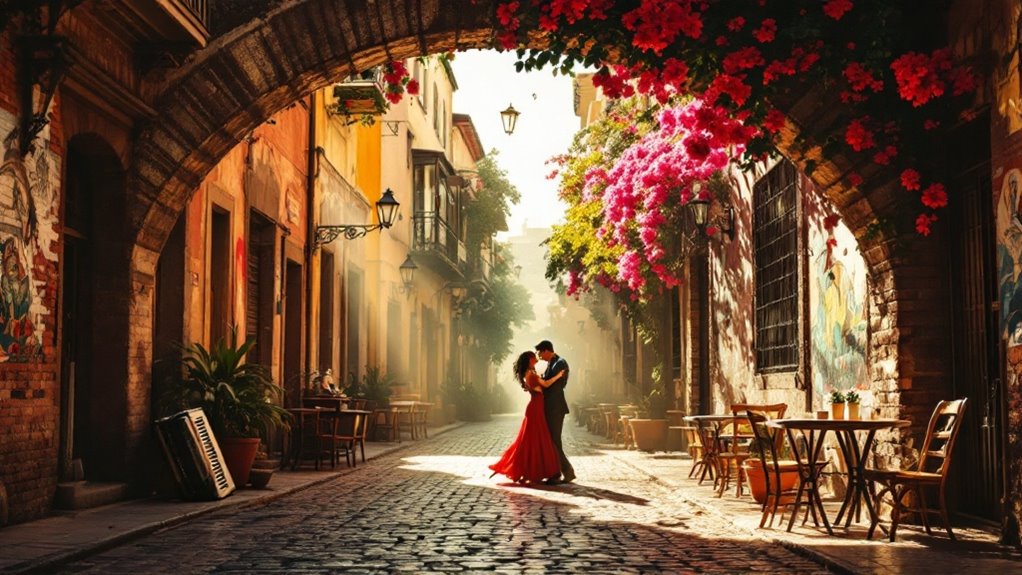
While many neighborhoods in Buenos Aires charm visitors, San Telmo distinguishes itself as the city's oldest and most historically rich district.
You'll discover yourself wandering cobblestone streets lined with colonial buildings, wrought-iron balconies, and lively street art that tells stories of immigrant life and political activism.
As the birthplace of tango, San Telmo's heart beats strongest at Plaza Dorrego, where spontaneous dance performances unfold and the famous Sunday antique market draws crowds. After the devastating yellow fever epidemic of 1871, wealthy families abandoned their grand Roman villas, which were later converted into immigrant housing.
Don't miss the historic Mercado San Telmo, dating from 1897, or the fascinating Zanjón de Granados tunnels that reveal the neighborhood's colonial past.
The area's artistic spirit thrives in its numerous galleries, while landmark buildings like Casa Mínima and San Telmo Parish Church showcase architectural heritage spanning three centuries.
Though its lively facades now draw travelers from around the world, La Boca began as a humble working-class port neighborhood shaped by Spanish and Italian immigrants in the mid-19th century.
The district's iconic colorful buildings emerged when residents used leftover ship paint from nearby shipyards to brighten their homes. The neighborhood's name comes from its location at the mouth of the Riachuelo river.
Resourceful La Boca residents transformed discarded ship paint into a vibrant neighborhood landmark, creating Buenos Aires' most colorful district.
You'll find the heart of La Boca along El Caminito, a 150-meter open-air museum where tango dancers perform and local artists display their work.
While the neighborhood is home to the famous Boca Juniors' La Bombonera stadium and striking political murals, it's best to stick to the main tourist areas.
Visit during mid-morning or late afternoon to avoid peak crowds, and take taxis rather than walking beyond El Caminito's core zone, as safety can be a concern in outer areas.
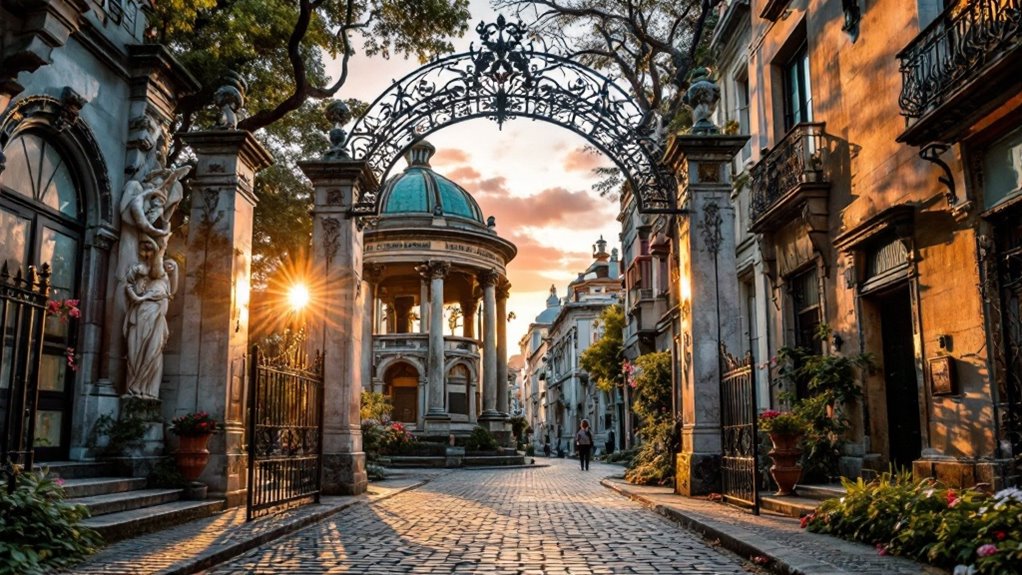
As Buenos Aires' most prestigious neighborhood, Recoleta showcases the city's European heritage through its grand Beaux-Arts mansions, tree-lined boulevards, and cultural landmarks.
You'll find French-inspired palaces along Avenida Alvear, now housing luxury hotels and designer boutiques. The neighborhood's crown jewel is La Recoleta Cemetery, where Gothic and Art Nouveau mausoleums tell stories of Argentina's elite, including Eva Perón's final resting place.
For culture enthusiasts, there's the National Museum of Fine Arts and the avant-garde Recoleta Cultural Center. When spring arrives, the streets come alive as jacaranda and lapacho trees burst into vibrant purple and pink blooms.
Take a break at La Biela café under ancient rubber trees, or browse the artisan fair at Plaza Francia. The modern Floralis Genérica sculpture, with its moving steel petals, offers a striking contrast to the area's classical architecture.
Moving away from Recoleta's opulence, the neighborhood of Almagro reveals Buenos Aires' authentic cultural heart. You'll uncover the birthplace of tango legend Carlos Gardel and religious landmarks like the striking Basílica María Auxiliadora with its candy-striped columns and night-blue ceilings. The basilica holds special significance as the baptism site of Pope Francis.
The area's rich cultural tapestry unfolds through:
Don't miss the Sunday Book Fair at Plaza Almagro or the weekend flea markets at Parque Centenario, where you'll come across everything from antiques to vinyl records among locals enjoying chess games and family picnics.
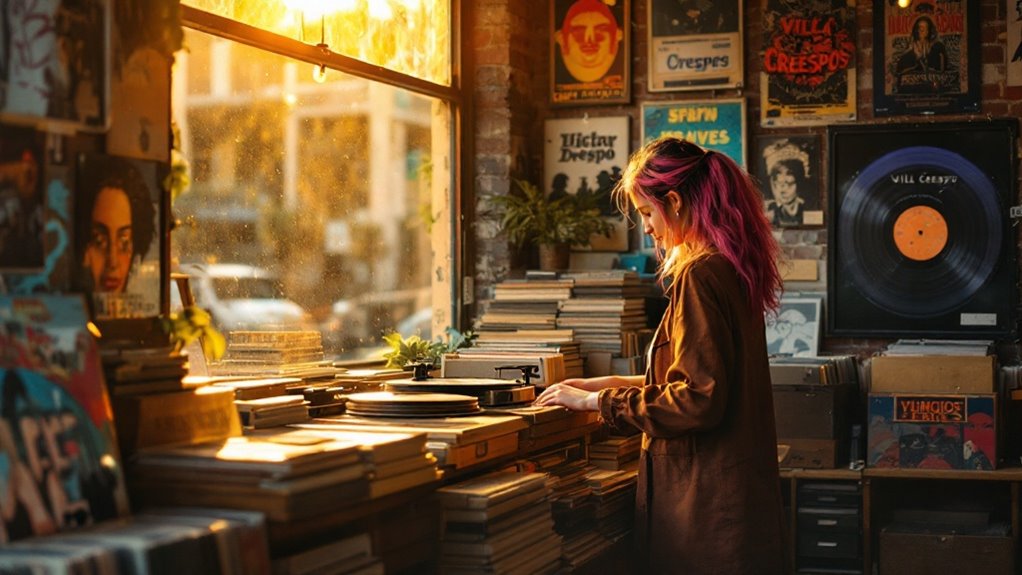
The rhythmic pulse of Villa Crespo beats through its blend of Jewish heritage, avant-garde arts, and vinyl culture.
You'll discover kosher markets and historic synagogues alongside experimental theater at Microteatro, where 15-minute plays showcase emerging talent.
Stroll down Calle Murillo to explore boutique leather shops, then catch live music at Club Cultural Matienzo or La Cultura del Barrio. The rich musical legacy includes legendary tango musician Pugliese, who called this neighborhood home.
The neighborhood's creative spirit extends to its culinary scene, where spots like Comander Bar and Imperio Pizzeria (since 1946) serve up local flavors.
Don't miss the historic Club Atlético Atlanta, or the lively murga performances during carnival season.
For vintage finds, browse the clothing markets along Scalabrini Ortiz Avenue, while Plaza Benito Nazar offers a peaceful escape from the bustling streets.
Tucked away from Villa Crespo's vinyl shops and theaters lies Buenos Aires' most intriguing residential maze: Parque Chas.
This compact neighborhood breaks from the city's traditional grid with its circular street pattern and radiocentric design, earning it the nickname "Bermuda Triangle" among locals. Much like its neighbor Villa Crespo's artistic spirit, the area attracts creative souls and cultural enthusiasts.
You'll encounter a tight-knit community where streets named after European cities spiral around a central plaza.
The area's unique character comes from its:
Despite its labyrinthine layout, you can easily reach Parque Chas via Line B Subte or several bus routes.
Once there, you'll come across a peaceful residential enclave that's inspired novels and photographers while maintaining its authentic Buenos Aires charm.
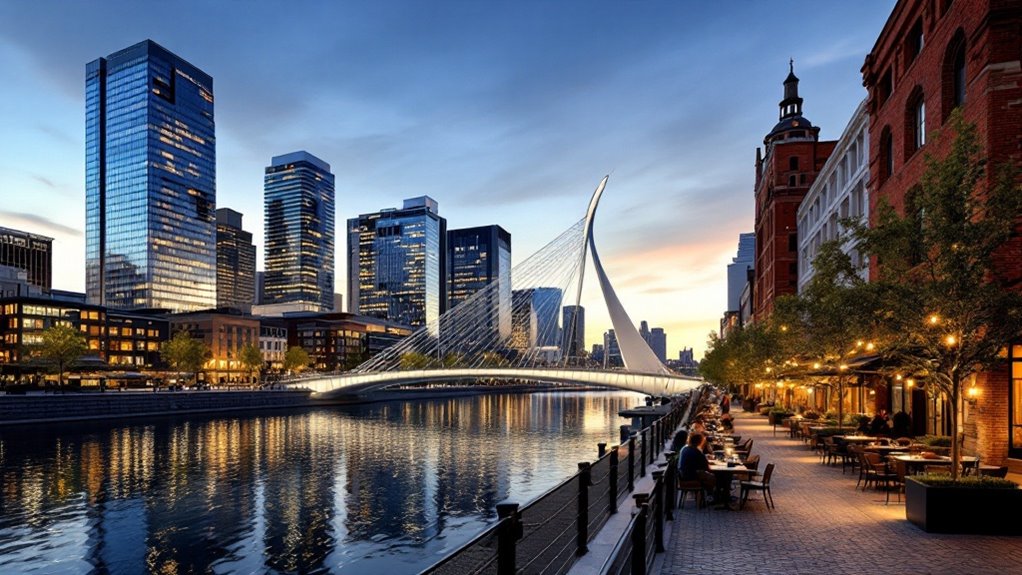
Once a derelict port complex built in the 1880s, Puerto Madero has transformed into Buenos Aires' most dramatic urban renewal success story.
The original port construction took 10 years to complete between 1887 and 1897.
You'll discover historic red-brick warehouses converted into upscale restaurants and cultural spaces along its interconnected quays.
The neighborhood's standout features include Santiago Calatrava's Puente de la Mujer bridge, resembling tango dancers, and streets uniquely named after prominent Argentine women.
You can explore the 865-acre Ecological Reserve, visit historic ships like the ARA Uruguay, or admire South America's tallest building, the Puerto Madero Tower.
While it's now Buenos Aires' priciest district with luxury condos fetching up to $8,000 per square meter, critics note its lack of traditional porteño character.
Still, this former industrial wasteland attracts 150,000+ daily visitors and contributes considerably to the city's economy.
You will discover Buenos Aires's neighborhoods offer endless possibilities for urban exploration. Whether you're drawn to San Telmo's cobblestone streets, La Boca's vivid facades, or Recoleta's sophisticated boulevards, each district tells its own story. Don't stick to just one area – hop between these unique enclaves to experience the city's full character. From tango to street art, these seven neighborhoods showcase the best of Argentina's capital.